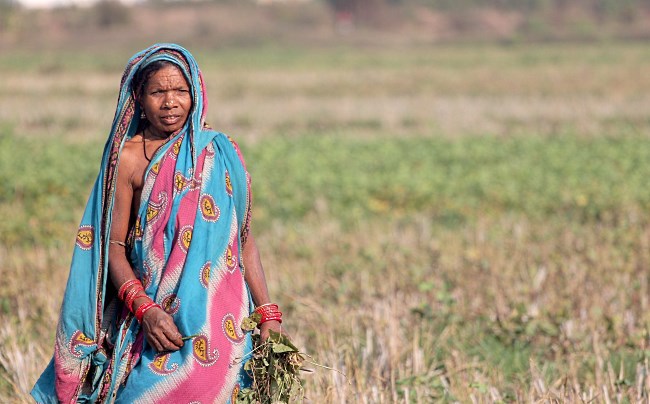Why 60,000 Indian Farmers Committed Suicide: Climate Change the Culprit
2 November 2017
According to the statistics compiled by the World Health Organization, around 800,000 people commit suicide every year[1]. Most suicides occur in low- and middle-income countries. As an example, India has more than 130,000 suicides each year. With more than half of India's working population employed in agriculture and one third of the population living below the international poverty line, the Indian public generally believes that the suicide rates of their country has a connection to the increasing variability of agricultural income. However, there were no quantitative research and relevant data supporting this argument. According to media reports, Tamil Nadu, a state in southern India, suffered this year the worst drought in the last 140 years, triggering hundreds of suicides. Skulls and bones said to belong to the farmers who killed themselves were piled up at central New Delhi for protest[2].
The University of California in the US published this year an in-depth analysis of the causes of the high suicide rates in India[3], shedding some light on the issue. The researcher analyzed the suicide rates from 1967 to 2013 reported by India, agricultural yields and climate data. It was found that the suicide rates had doubled since 1980 and there were close relationships between the annual suicide rate, agricultural yield, and the temperature and precipitation of the growing season. The study result showed that an increase in temperature during the growing season would reduce the agricultural yield and increase the suicide rate. Similarly, a decrease in precipitation during the growing season would decrease the agricultural yield and increase the suicide rate. In contrast, variations of temperature and rainfall in non-growing seasons showed no impact on suicide rates. The study further revealed that the impacts of temperature and rainfall during the growing season could last several years. Another important finding was that there seemed to be no adaptation measures taken by India to reduce the impacts brought about by climate change. It was estimated that climate change in the last three decades had already taken a toll of more than 59,000.
The Fifth Assessment Report of the Intergovernmental Panel on Climate Change stated that climate change had an overall negative impact on global agricultural yield. As the climate continues to warm, the major agricultural yields in tropical and temperate regions will continue to decrease if there are no adaptation measures in place. The Paris climate summit agreed to keep global temperature rise below 2oC. However, based on the existing pledges made in the Paris Agreement, global temperature rise by the end of this century is likely to be around 3oC relative to pre-industrial levels. Climate change is threatening the survival of some of the vulnerable populations. While we should strengthen our emission reduction efforts to keep the temperature rise in check, we also need to be prepared for the impacts brought about by the warming climate.
Everyone has compassion on others, not to mention thousands of lives. Could we afford to procrastinate in taking actions to mitigate and adapt to climate change?

Figure 1Climate change is threatening the survival of some of the vulnerable populations (Courtesy: Pixabay)
F.C. Sham
References:
[1] World Health Organization: Suicide fact sheet
http://www.who.int/mediacentre/factsheets/fs398/en/
[2] Climate change linked to 60,000 farmer suicides in India over the last three decades, study claims
http://www.scmp.com/news/asia/south-asia/article/2104987/climate-change-linked-60000-farmer-suicides-india-over-last
[3] Climate change causing suicides in India as crops fail
http://news.berkeley.edu/2017/07/31/study-climate-change-already-causing-suicides-in-india-as-crops-fail/
The University of California in the US published this year an in-depth analysis of the causes of the high suicide rates in India[3], shedding some light on the issue. The researcher analyzed the suicide rates from 1967 to 2013 reported by India, agricultural yields and climate data. It was found that the suicide rates had doubled since 1980 and there were close relationships between the annual suicide rate, agricultural yield, and the temperature and precipitation of the growing season. The study result showed that an increase in temperature during the growing season would reduce the agricultural yield and increase the suicide rate. Similarly, a decrease in precipitation during the growing season would decrease the agricultural yield and increase the suicide rate. In contrast, variations of temperature and rainfall in non-growing seasons showed no impact on suicide rates. The study further revealed that the impacts of temperature and rainfall during the growing season could last several years. Another important finding was that there seemed to be no adaptation measures taken by India to reduce the impacts brought about by climate change. It was estimated that climate change in the last three decades had already taken a toll of more than 59,000.
The Fifth Assessment Report of the Intergovernmental Panel on Climate Change stated that climate change had an overall negative impact on global agricultural yield. As the climate continues to warm, the major agricultural yields in tropical and temperate regions will continue to decrease if there are no adaptation measures in place. The Paris climate summit agreed to keep global temperature rise below 2oC. However, based on the existing pledges made in the Paris Agreement, global temperature rise by the end of this century is likely to be around 3oC relative to pre-industrial levels. Climate change is threatening the survival of some of the vulnerable populations. While we should strengthen our emission reduction efforts to keep the temperature rise in check, we also need to be prepared for the impacts brought about by the warming climate.
Everyone has compassion on others, not to mention thousands of lives. Could we afford to procrastinate in taking actions to mitigate and adapt to climate change?

Figure 1Climate change is threatening the survival of some of the vulnerable populations (Courtesy: Pixabay)
F.C. Sham
References:
[1] World Health Organization: Suicide fact sheet
http://www.who.int/mediacentre/factsheets/fs398/en/
[2] Climate change linked to 60,000 farmer suicides in India over the last three decades, study claims
http://www.scmp.com/news/asia/south-asia/article/2104987/climate-change-linked-60000-farmer-suicides-india-over-last
[3] Climate change causing suicides in India as crops fail
http://news.berkeley.edu/2017/07/31/study-climate-change-already-causing-suicides-in-india-as-crops-fail/